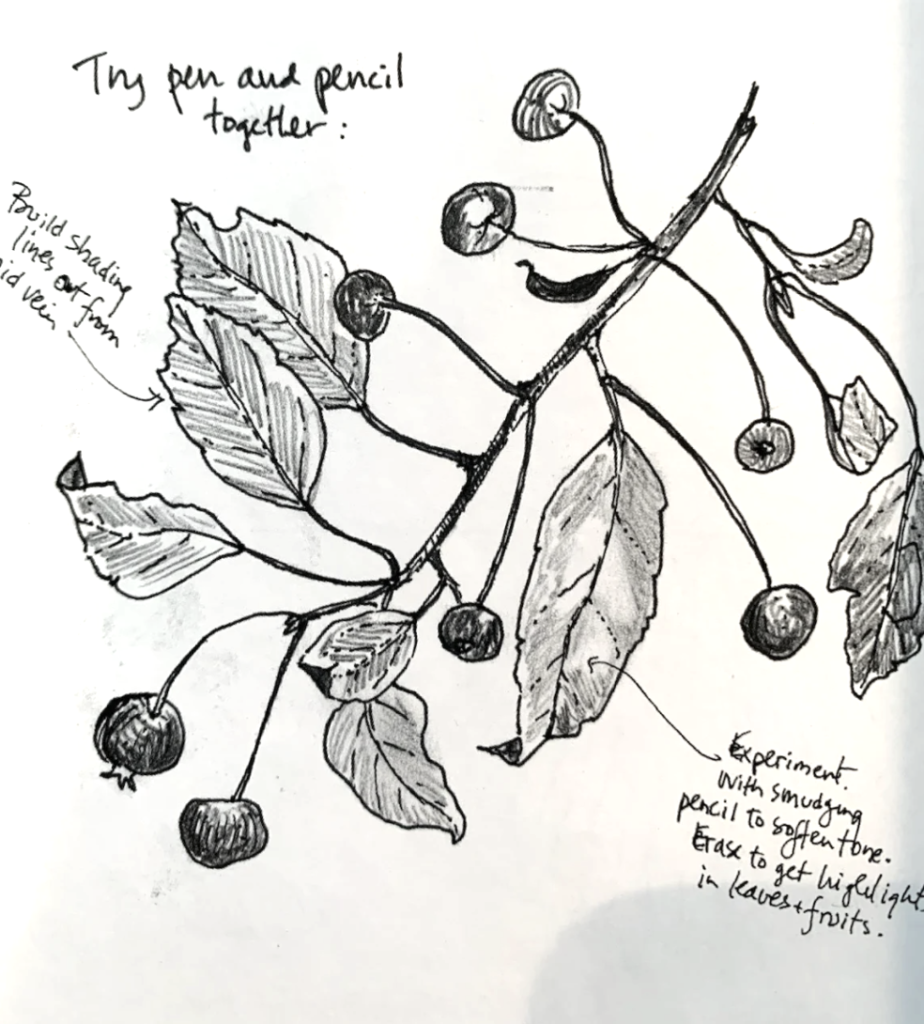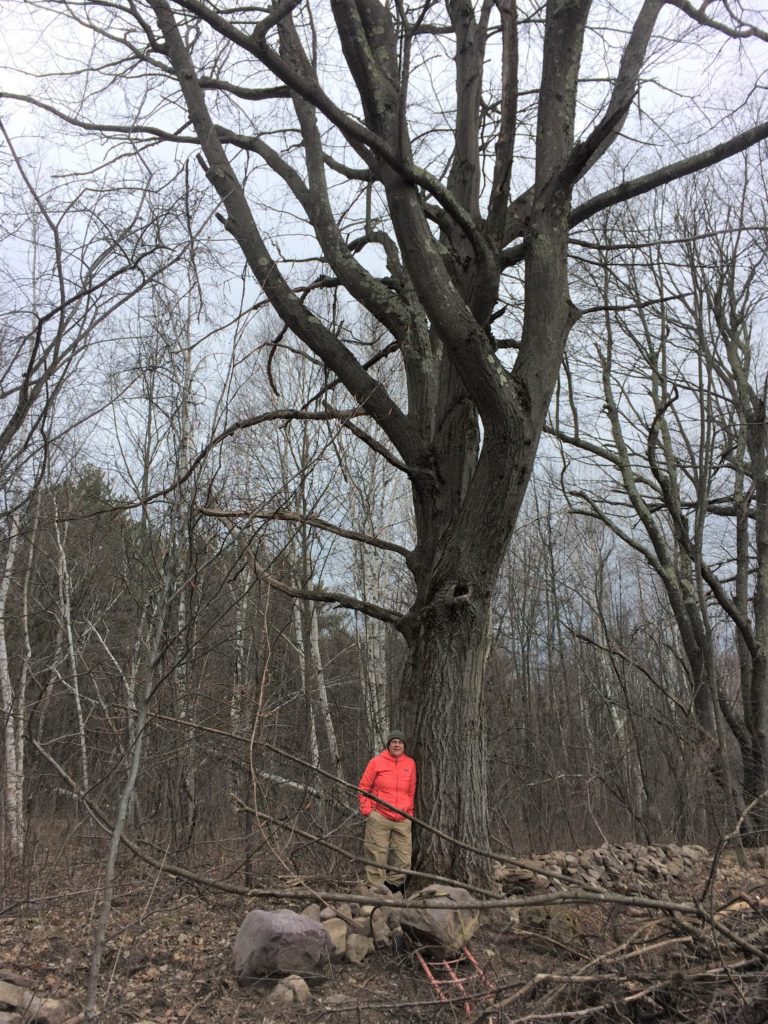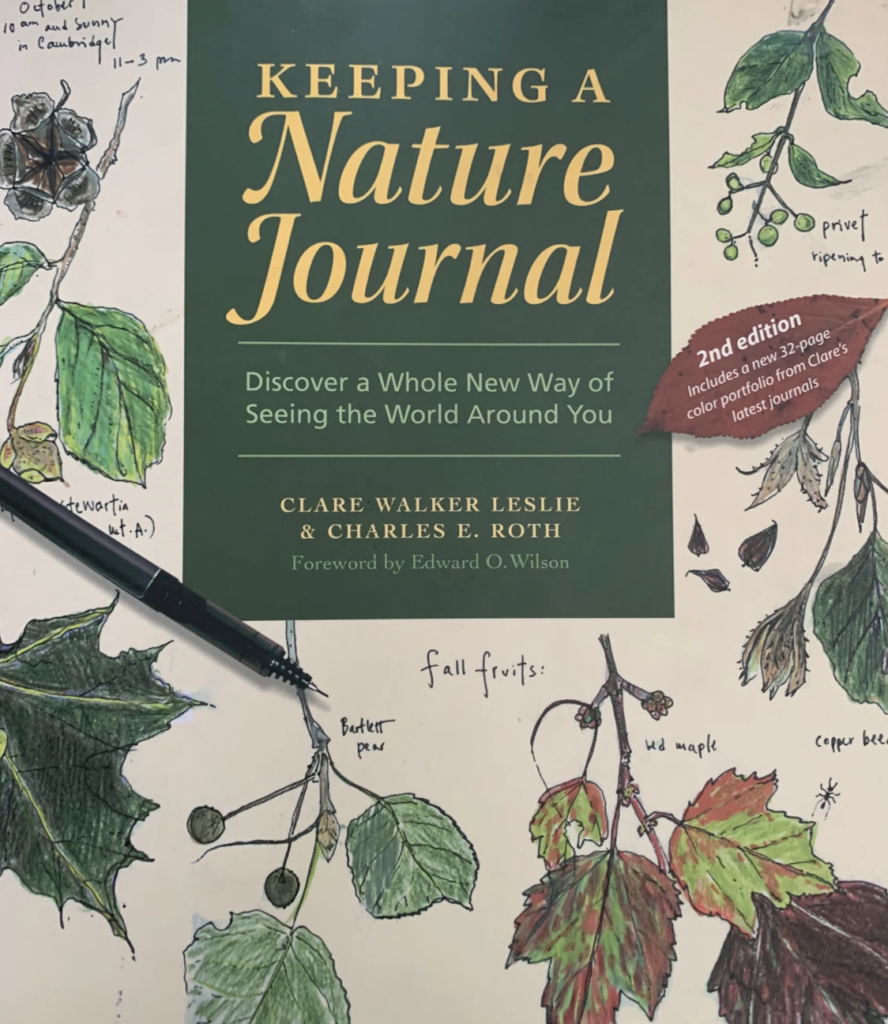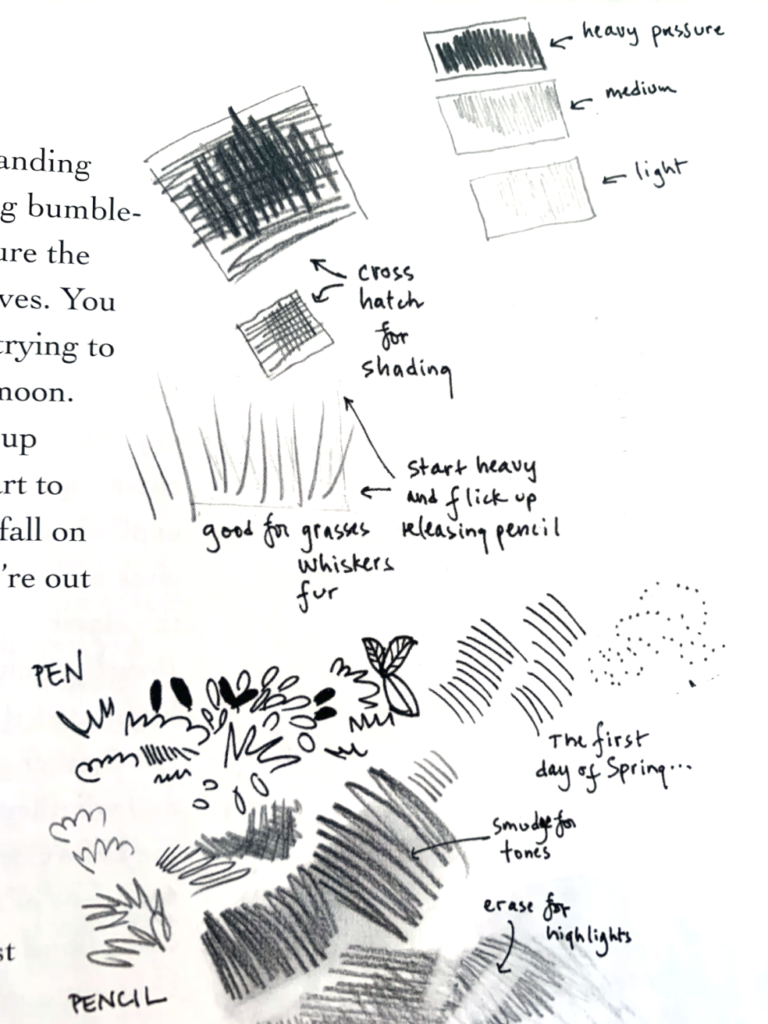 In this course, we explore botany through close observations of plants and through the writings of scientific and literary observers. We read, reflect, and discuss as a class, take independent field notes in our journals, sketch field drawings outdoors, and create in-depth artistic renderings and detailed writings of our observations.
In this course, we explore botany through close observations of plants and through the writings of scientific and literary observers. We read, reflect, and discuss as a class, take independent field notes in our journals, sketch field drawings outdoors, and create in-depth artistic renderings and detailed writings of our observations.
Students have daily classes where they learn scientific terminology, the plant life cycle, and how to use identification books. They also practice making comparisons and finding connections to further their understanding. Students read from prominent nature writers and apply this material to their own experience of plants.
From all of these varied experiences, students develop a conscious picture of what is involved in forming a meaningful, deep relationship with nature, including the following critical elements: the significance of attention to detail, cultivating interest, our biases, gesture, gratitude, and reciprocity. Students also write daily reflections to practice self-awareness of their own learning process.
Reading Assignment
Pilgrim at Tinker Creek, by Annie Dillard (1974, a nonfiction text
Read from the top of page 22 (“Where Tinker Creek flows…”) to the end of the paragraph on page 27 that finishes with “I’m blind as a bat, sensing only from every direction the echo of my own thin cries.”
Mark down what strikes you, questions you have, or experiences you have had that relate to the reading.
Here is the audio file if you would prefer to listen to the passage. This text is quite dense, so please focus and do not multi-task while you are listening.
Reflection Assignment
From Annie Dillard: “But if you cultivate a healthy poverty and simplicity, so that finding a penny will literally make your day, then since the world is in fact planted in pennies, you have with your poverty bought a lifetime of days. It is that simple. What you see is what you get.” pg 16
Some people might think it is boring to just look at the end of a branch or the shape of a tree. How does one go about cultivating interest? This takes effort.
Prompt: How do you cultivate interest? How do you find interest initially? How do you sustain that interest? Give examples from your botany experience so far.
Remember:
• Use accurate and thorough description so that the reader can imagine what you are seeing, but only for aspects that are relevant to your point
• Make connections! 1) to the prompt 2) to your personal experience of the phenomena 3) to the readings. Share your own insights and questions
Field Observation Assignment 1
Notes: Please attach a photo of your field journals to this assignment
Please put your phone on “Do NOT DISTURB” with vibrate and sound turned off.
- Find a tree that you are drawn to (not coniferous or evergreen, so not with needles). It will probably not have leaves yet, but buds may be opening. Make sure the tree is in a convenient place as you will be visiting it and its surrounding area each day.
- A) Observe and draw the overall tree:
First impression: What drew you to this tree? Not more than a couple of sentences.
State location and date. Observe your tree starting at the bottom and slowly looking up all the way to the top into the canopy. Now, slowly look down the tree.
Draw the tree – draw the whole tree trying to capture as much detail as possible. Capture proportion and how it branches. Do the branches reach more upwards or out? Drawing trees can be hard, do your best.
- B) Observe and draw branch detail:
Draw about 1 foot of a branch ending, preferably from your tree. If branches aren’t within observing distance, draw the branches of another similar, smaller tree. Capture details.
- C) What questions do you have about the tree and/or end of the branch?
- For the rest of the time, 45-60 minutes – go for a walk in a natural area: woods or fields. You might walk 1-3 miles. You can take someone with you if you don’t feel comfortable being by yourself, but you must be quiet and observing.

As you walk, look around, up, and down. Remember we are observing the natural world, not man-made items.
Look up into the tops of trees.
What do you observe?
In general, what is growing? What is turning green? Are there other colors on living plants? What is still dormant?
What stands out to you?
Finally, be on the lookout for stumps where a tree has been cut down and you can see the rings.
Please return no later than 2:40pm to gather in our Google Meet call for discussion and reflection.
Teacher notes:
Here is a picture of my tree. I am looking forward to seeing your trees!
Field Observation Assignment 2
Preparing to draw the bark of your tree.
 Start by creating a small value scale somewhere on the side of your drawing page for today. Create at least three squares or areas about the size of your fingernail. Make one as light as you possibly can, the second a bit darker and the third darker still. You can do this by crosshatching or shading with the side of the pencil. You can do more values/tones from light to dark. This will help with your drawings by creating contrast. You can do the same thing with color. Make several squares that depict the color palette that you see in the bark of your tree. Mixing colors is important here so that you don’t just get brown, but perhaps a greenish brown or yellowish brown. I have posted some more sketching samples from Keeping a Nature Journal by Clare Walker Leslie and Charles H Roth.
Start by creating a small value scale somewhere on the side of your drawing page for today. Create at least three squares or areas about the size of your fingernail. Make one as light as you possibly can, the second a bit darker and the third darker still. You can do this by crosshatching or shading with the side of the pencil. You can do more values/tones from light to dark. This will help with your drawings by creating contrast. You can do the same thing with color. Make several squares that depict the color palette that you see in the bark of your tree. Mixing colors is important here so that you don’t just get brown, but perhaps a greenish brown or yellowish brown. I have posted some more sketching samples from Keeping a Nature Journal by Clare Walker Leslie and Charles H Roth.
- Draw the bark of the tree trunk. Try to capture an 8-12 inch square.
- Look around you and begin to notice what is in the area around your tree. Observe today as chances are it will be different in a few days. Look closely at how your tree goes into the earth. What grows around it?
- If you haven’t already, please document the differences between your tree and a different tree that you experienced with the gesture drawing yesterday.
For your walk:
1) Practice looking in detail, actively seeing for a specific aspect of a tree:
— by looking at bark on other trees
— or buds or branches or canopy
2) Practice letting go, which is still very active, but not directed. Try the following:
— blur your eyes
— “unpeach the peaches”
— focus on the periphery using your fingers to find the periphery and then dropping them
Botany observation and artistically done field notes:
A large part of getting to know the natural world is learning to really observe it. We will use various techniques to observe plants carefully, including drawing, journaling, and shared observations. To help with observation, there will be a significant artistic component to the observation journal.
Finally, it is important to be respectful and safe during our fieldwork:
• Please be environmentally and community conscious. Avoid trampling areas, pick up all of your stuff, respect others’ property, etc.
• Generally, please do not pick flowers or take plants apart in the field; if we are going to do that, I will let you know. Otherwise, we may bring specimens to class.
• Make sure you have the proper clothing for the afternoon including sun and rain protection and another warm layer for comfort. Remember you will be sitting and drawing for 30 minutes or more. Wear insect repellent and/or treated clothing if possible.
• AND, always check for ticks when you return.
Observation Journals and Quizzes
Keep an observation journal while in the field. You must have observational sketches of each plant and its environment with some supporting description as needed.
“Why should field notes include drawings? For one thing, drawing makes you look more carefully at your subject. As an observational tool, drawing requires that you pay attention to every detail – even seemingly unimportant ones. In creating an image (no matter how skillfully), the lines and tones on the paper provide ongoing feedback as to what you have observed closely and what you have not. If, for example, up to a certain point you have ignored the toes of your mammal, a quick glance at the toeless creature on your page will direct your attention to precisely that neglected feature. Just the act of making a drawing will force you to examine each and every part of your subject.” (from Field Notes on Science and Nature by Michael R. Canfield, pg 161-162)
- Your sketches should be as detailed as possible, but not necessarily “complete”. For example, you might only capture the texture on part of the stem and then do a quick outline for the rest. Or, you might only color one petal instead of all six.
- The minimum description includes plant name, date, area for the observation. You might also use some additional description for aspects that you just can’t capture with sketching. When we do plant identification, you will write relevant descriptions. Observation journal writing can be in phrases, it does not have to be complete sentences. All writing must be legible.
- Drawing expectations may also include exercises in gesture drawing and contour line studies in addition to the above observation sketches. There may be a sustained study or final drawing assigned during the block. Ms. Laird will work with students to support their drawing and observation skills and the creation of the observation journal as an aesthetic as well as scientific compilation of observations in the field.
- Quizzes – there will be quizzes on terminology
- Reflections and Compositions – done at home, turned in each day
- Reflections – Based on the plant or experience of the natural world we observed that day, your reflections might include your thoughts on connections to other plants or to the readings, insights into your experience of the plants, and/or questions you have, or even musings about the plant or readings. These should not just be a summary of your observations, although you can start with those. Initially, we will provide guided, open-ended questions for reflections.
Before you write, start with a review of your observations (in your mind). To begin, a free write on your relationship to the topic is a fine place to start, but remember that you need to pass through and edit your thoughts afterward for clarity and depth. You should spend 30-45 minutes (and more at your own choosing). Reflections should be close to a page or longer in length.
- Compositions – There will be several compositions during this block in which you write a longer response to given prompts. As formal pieces, they need to be organized into Intro – Body – Conclusion format and you may want to formulate your thoughts in an outline before you begin. These essays should include content and direct quotes from class material as well as your own insights.
- What to bring for your afternoon in the field:
• Your journal - • Drawing pencils and colored pencils (you should not need a pen)
- • A small pack to carry stuff as needed
- • Water
- • Mud boots or good walking shoes/boots that work where it is wet, muddy, or cold
- • Insect repellent for ticks, also clothes that have been treated with permethrin if your family supports that.
- • Long pants that you can kneel and sit in
- • Long-sleeved shirt for sun protection or protection from scratchy brush
- • Something to sit or kneel on (optional) – can be your jacket, a pad, or a portable camp chair
- • Warm layers, rain gear, or sun hat depending on the weather
Learn more about our admissions process, and contact our admissions office if you have any questions.


